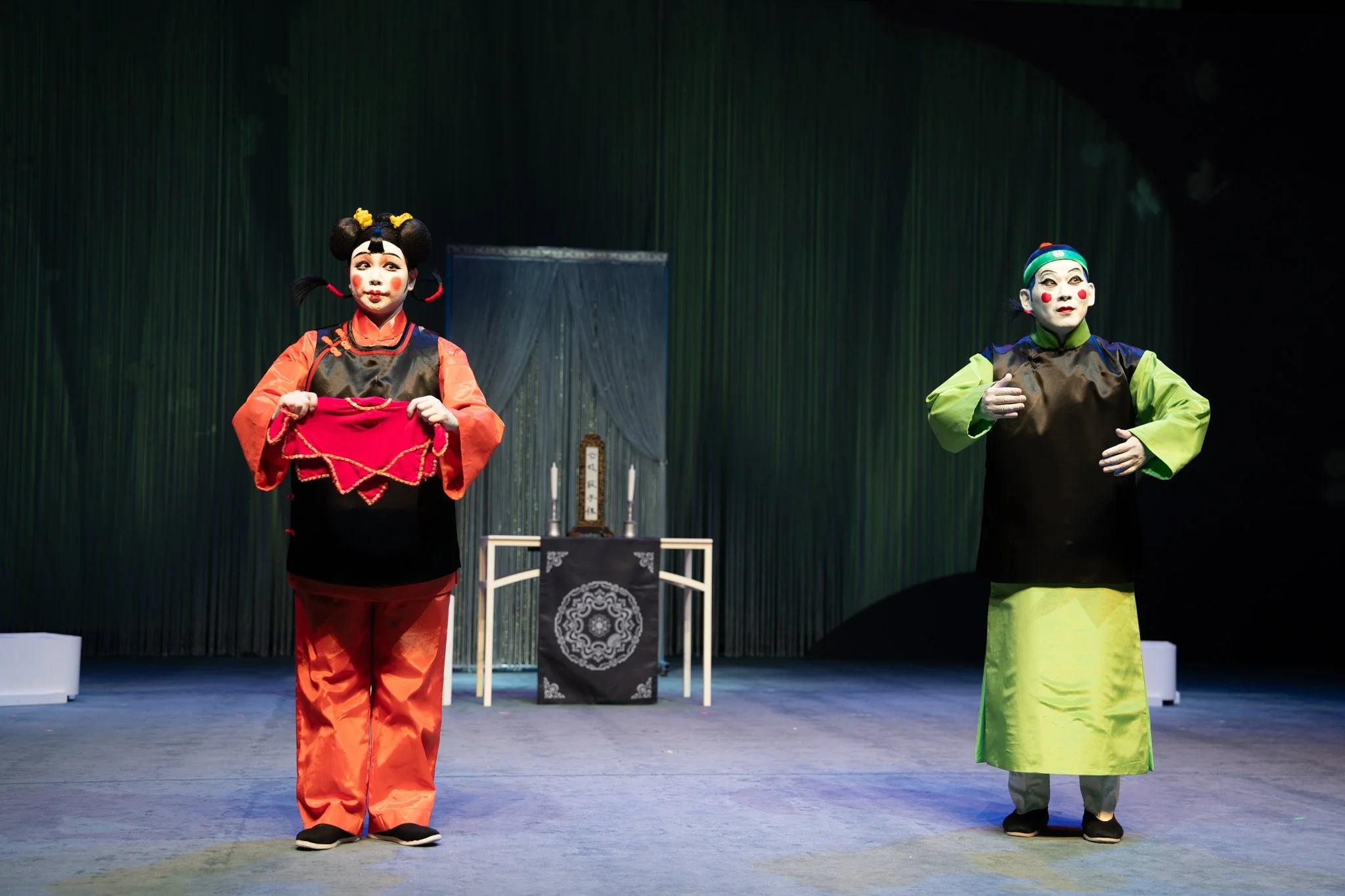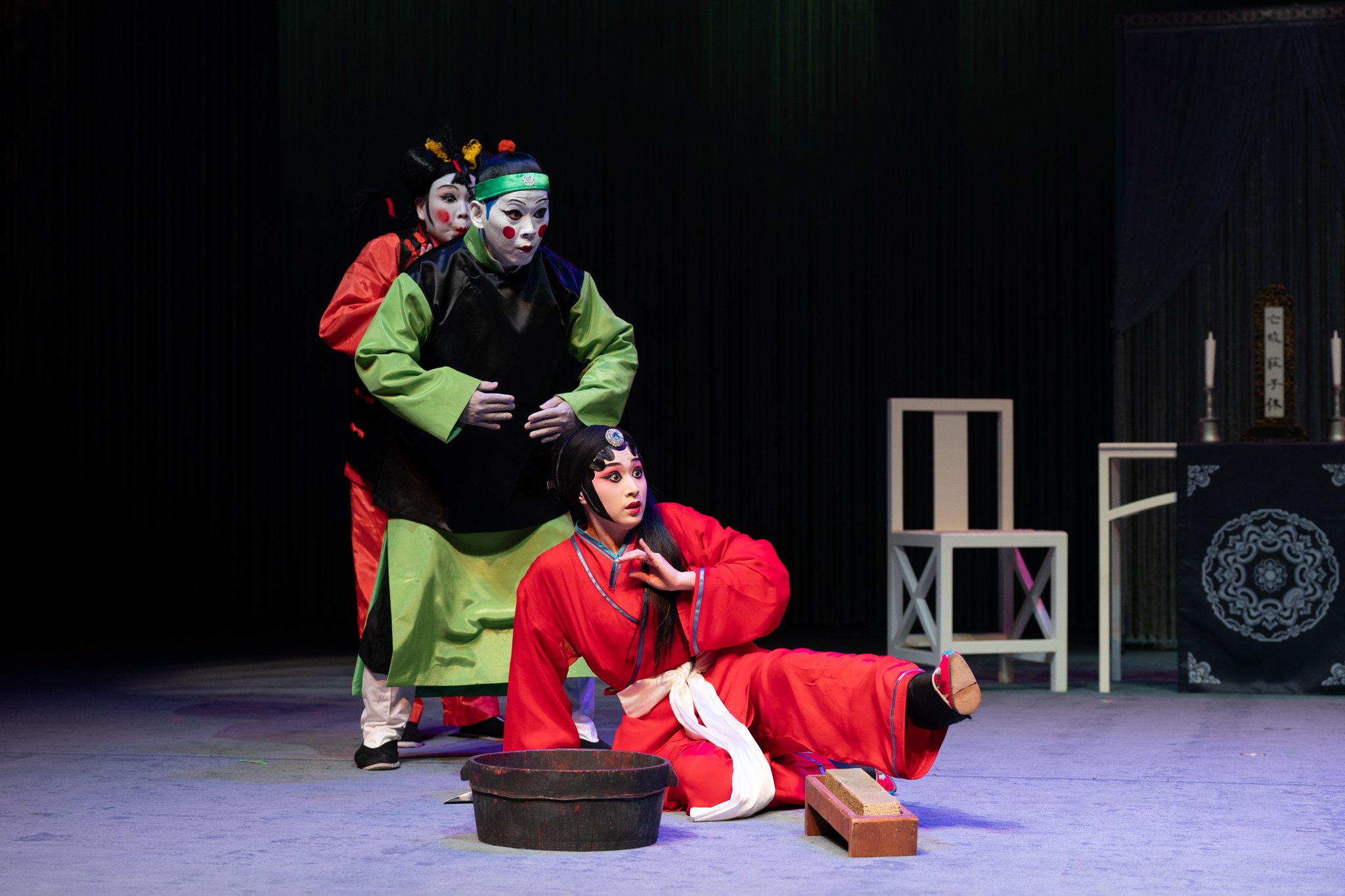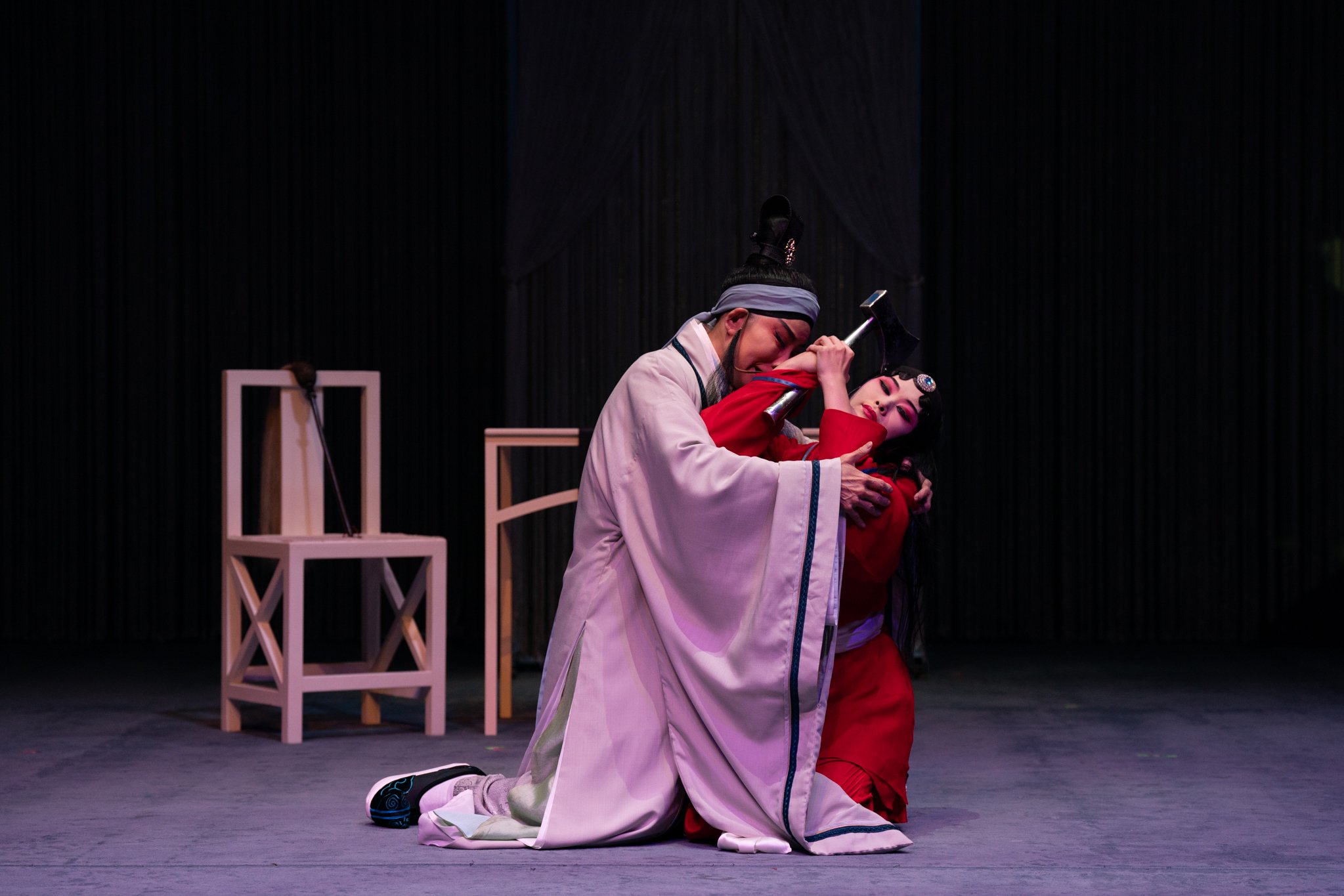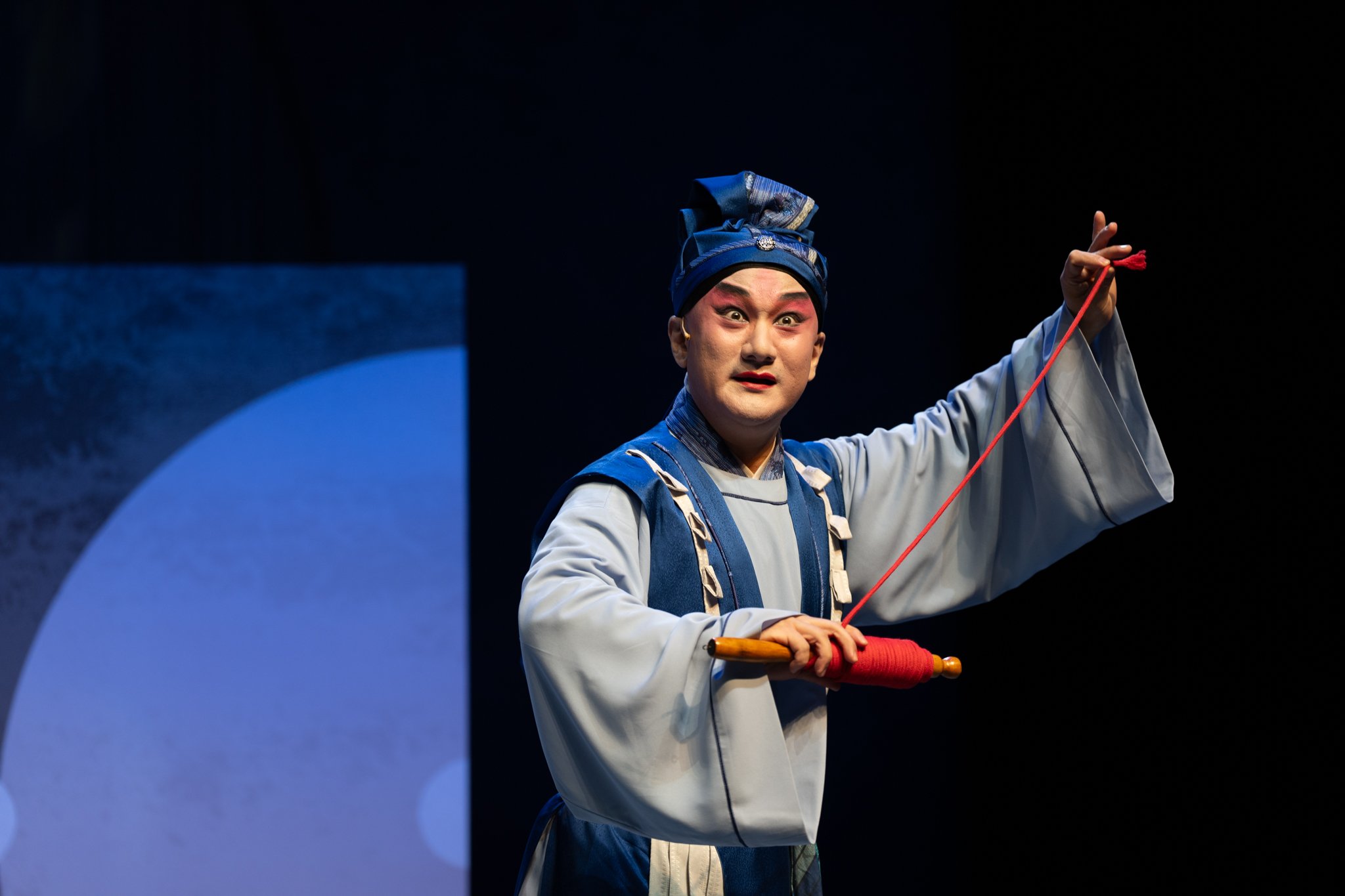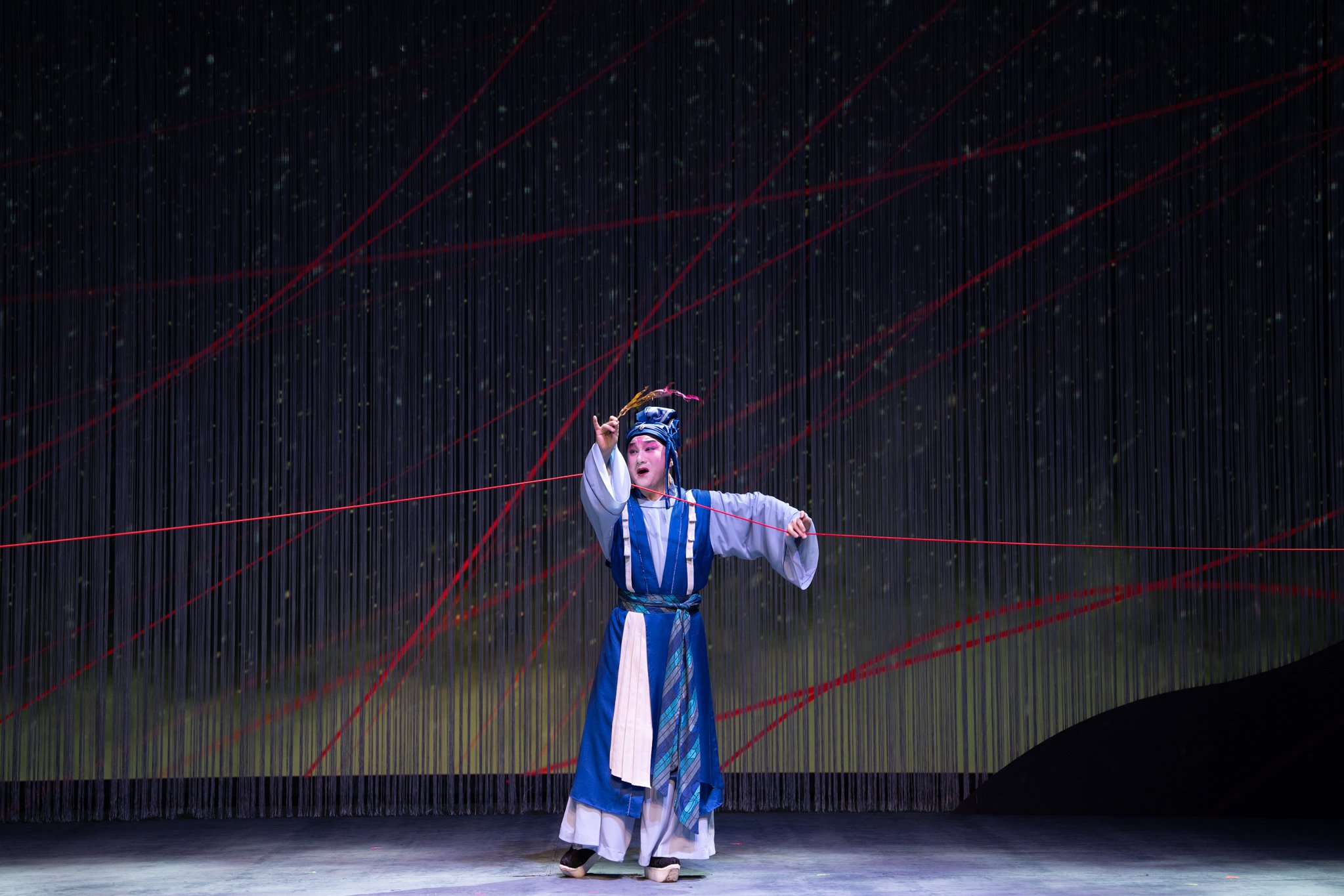Awakening Through Peking Opera: Life and Death from Script to Reality
GuoGuang Opera Company’s latest production, A Dream of Death and Life, hints at a profound connection between the stage and our reality, where the drama unfolds not only within the theater's walls but potentially in the lives of the audience.
Sense of Wander: ★★★★☆
In A Dream of Death and Life, philosopher Zhuangzi reflects on the concept of life and death. Image courtesy of GuoGuang Opera Company.
TAIPEI, Taiwan — All of us come to this world to learn. Whether consciously or not, we’re constantly in search of answers to questions such as “What is life?” “What is death?” and “What’s after death?”
For truth-seekers, GuoGuang Opera Company’s latest production, A Dream of Death and Life (死生一夢), may unveil one of life’s deepest secrets that we all struggle to comprehend: life and death are nothing more than a dream.
A Dream of Death and Life combines two opera plays into one: “Zhuangzi Tests His Wife” (試妻劈棺), and “A Puppet Play of Illusion” (傀儡幻戲). The former is adapted from the troupe’s classic repertoire, Breaking Open the Coffin (試妻大劈棺), which chronicles the story of Zhuangzi (circa 369—286 B.C), the influential Chinese philosopher credited with writing one of the foundational text of Taoism. In this story, Zhuangzi fakes his own death and transforms himself into a young man to test the loyalty of his wife, Lady Tien.
In their encounter, the young man pretends to be sick and claims to need a "brain" as a remedy. Lady Tien, driven by desperation, devises a scheme: she could retrieve the brain from her recently departed husband to cure her lover.
One captivating element in “Zhuangzi Tests His Wife” is the pair of paper dolls placed at the funeral. According to Taoist tradition, paper dolls or figurines, also known as “Golden Boy and Jade Girl”, are placed in the memorial hall of the deceased. One of the purposes is to guide the departed to the “Land of Bliss”, also known as Sukhavati in Buddhism, in the afterlife, tending to their needs.
In the play, Zhuangzi, using his magic skills cultivated from Taoist practices, breathes life into these lifeless dolls. They vigilantly observe every action and word spoken by Lady Tien in the memorial hall, particularly her inner struggle over whether to open her husband’s coffin and extract his brain to cure her lover, all the while unaware that her lover is actually her husband in disguise.
The two paper dolls that stood in the memorial hall come to life when Lady Tien is offstage. Image courtesy of GuoGuang Opera Company.
The two dolls observe Lady Tien from behind as she sharpens her axe in anticipation of her attempt to open the coffin. Image courtesy of GuoGuang Opera Company.
These two paper dolls, one dressed in red and another in green, add a touch of colour to this otherwise solemn and tragic play. When Lady Tien is present in the memorial hall, they remain motionless on either side, as if lifeless. But after she exits the stage, they come to life, moving in robotic motion. At one point, the two even attempt to catch the butterflies depicted in the background projections, though their efforts end in a tangle of limbs, rather than success.
When Lady Tien is about to take action, Zhuangzi miraculously “resurrects”, catching his wife in the midst of her unfaithful act. Overwhelmed with guilt, Lady Tien used the same axe to end her own life — an act that surprised Zhuangzi.
Originally a timeless classic that explores the psychological struggles faced by women in feudal society who grappled with the challenges of widowhood and remarriage, the play also casts a critical eye on the selfishness of men, thus scrutinising the fundamental values of marriage in traditional Chinese society.
The ethical dilemma of Lady Tien, who had waited for a decade for her husband to return from “his pursuit of the Tao”, and her subsequent feelings for someone else, remains a matter for no one but those directly involved to judge. Yet, in the end, we see Zhuangzi holding onto his deceased wife in his arms, as if contemplating his own actions, which ultimately lead to the tragic fate of Lady Tien.
Zhuangzi is saddened to witness his guilt-ridden wife taking her own life. Image courtesy of GuoGuang Opera Company.
As the curtain falls on “Zhuangzi Tests His Wife”, the philosopher leads us to the next play: “A Puppet Play of Illusion”.
Inspired by a painting from the Southern Song dynasty (1127–1279), A Picture of Skeleton, this play, written by Hong Qing, debuted in 2015. In this fresh adaptation of the tale, the enchanting worlds of puppetry and Peking opera intertwine.
“A Puppet Play of Illusion” revolves around a gifted puppeteer, Zhang Cong, who, in a twist of fate, resurrects his godsister. The play commences with Zhang Cong and his attendant entering the theatre. To our surprise, instead of proceeding directly onto the stage, they climb up the stairs leading to the seating area, making a roundabout before taking the stage. This unconventional approach defies opera conventions, shattering the invisible barrier between spectators and performers.
The story goes that Zhang Cong returns home to visit his foster father, only to discover that he has been living with the deceased body of his granddaughter Dong for years. To console his foster father, Zhang employed a once-in-a-lifetime secret technique inherited from his master to bring Dong “back to life”. The one condition to keep Dong alive, as we are told, is that the puppet and the puppeteer must remain within arm's reach of each other.
The skilled puppeteer Zhang Cong, holding the crimson thread, is about to bring Dong back to life. Image courtesy of GuoGuang Opera Company.
Ever since Dong is resurrected, she spends day and night with Zhang Cong. Image courtesy of GuoGuang Opera Company.
Aside from the plot, what adds an intriguing dimension to the play is that the actress portraying Dong incorporates "marionette puppet movements" from Liyuan opera traditions. This artful emulation breathes life into the puppet, blurring the line between life and death. What’s more, the entire performance is executed with the actress walking on high stilts, mimicking the appearance of women with bound feet — a skill that requires years to master.
To complement the performance, digital animation is employed in the backdrop. During a snowstorm scene where Dong and his grandfather are in search of medicinal herbs to cure the ailing Zhang Cong, the wintry landscape evokes that of a woodblock print by Japanese artist Katsushika Hokusai, where travelers are seen braving tempestuous fields covered in snow.
The play reaches its zenith in Act II, titled “Spring Dream”, where Zhang Cong and Dong engage in acting a scene from the renowned Chinese literature, Journey to the West. This particular tale centres on the White-Bone Spirit (portrayed by Dong) who requests Buddhist monk Tang Sanzang (played by Zhang Cong) to marry her in order to prolong her life — a storyline mirroring the complexities of Zhang and Dong's relationship.
In this play-within-play, Zhang Cong's affection for Dong becomes apparent. Despite his role as a puppeteer, he appears almost like a puppet himself, unable to distinguish the boundary between dream and reality, entangled in this “reality” that he himself has created. However, following Dong's death during an excursion to collect herbs — when the puppet is no longer within the puppeteer’s reach — Zhang finally awakens from his “dream”.
In “A Puppet Play of Illusion”, Zhang Cong, a puppeteer who supposedly wields control over the puppet, becomes entangled in this “reality” that he has created. Image courtesy of GuoGuang Opera Company.
The fusion of classic and contemporary plays, coupled with the integration of digital technology, breathes vitality into the time-honoured traditions of Peking opera, attesting to the troupe's endeavour to explore the possibilities and navigate the potential of this treasured art form.
A Dream of Death and Life succeeded in drawing the audience’s attention to the fact that what happens in this “dream” on stage is a mere reflection of the reality unfolding offstage.
The notion that “life is all but a dream” is not unfamiliar to most audiences in Taiwan, where the prevailing Buddhist belief propagates that “All things contrived are like a dream, an illusion, a bubble, a shadow; and as a dewdrop or lightning,…” as articulated in the Diamond Sutra. While it’s not difficult for us to grasp that everything in this world is essentially illusory, we often don’t fully realise this truth unless we undergo experiences such as losing our loved ones or emerging from trauma, much like what Zhangzi and Zhang Cong encounter.
But much like the two protagonists onstage, we often tend to believe that we have control over our lives, or at the very least, we can attempt to steer our destinies. This may be true, but perhaps only to a certain extent.
When we come to grasp the notion that “Life and death are but a dream. We all ultimately turn into dust,” as the play poignantly concludes, we might start to view the world through a different lens. The skull that Zhuangzi holds onto throughout the second half of the play symbolises more than just the end of life; it serves as a reminder of the world beyond death. It’s as if the great philosopher himself, much like the rest of us, is in pursuit of the life’s ultimate reality.
“A Puppet Play of Illusion” draws its inspiration from “Skeleton Puppet”, a painting by the Southern Song dynasty painter Li Sung. The painting is now in the Palace Museum Collection in Beijing, China.
Reference:
Program notes for “A Double Bill of Magic Jingju Art”. September 8-10, 2023, Taipei Performing Arts Centre, Taipei.
A Dream of Death and Life is part of the program “A Double Bill of Magic Jingju Art” by GuoGuang Opera Company, which ran from September 8 to 10, 2023 at the Taipei Performing Arts Centre.


